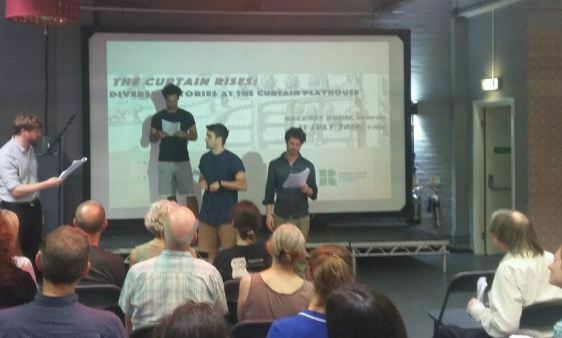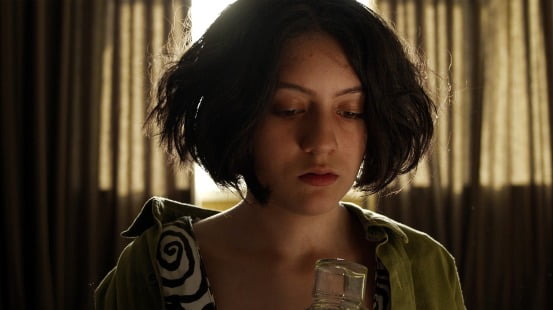
Skimming through Twitter early on a Saturday morning I caught sight of a message from the Before Shakespeare project. It invited its followers to come to an event that afternoon to celebrate and explore the history of The Curtain, one of the first London 16th-century theatres, whose archaeological site was only recently discovered. So off I went.
The Twitter start to the adventure is pertinent, because Before Shakespeare is the kind of academic project that seems to exude a particular extra energy because of social media. It is not just the messaging, but the enthusiasm that such messages both channel and encourage. Everyone involved seems that much more exhilarated, at what can be found and how it can be explained. Twitter, and the behemothic social media channels in general, are getting an increasingly critical press, for how they spread falsity and dissension. But they also create happiness to an extraordinary degree, through the instantaneousness of connection. The modern research project does not discover, compose, publish and then wait for a reaction. Instead, we all discover together.
So it was that I turned up at Hackney House in Shoreditch, on a swelteringly hot day, when some 60 or 70 enthusiasts for 16th century drama were gathering for four hours of entertainment. The excitement was palpable. On offer was a mixture of talks, play extracts (performed by The Dolphin’s Back, a small theatrical group devoted to staging forgotten early modern plays) and a vivid display of fencing combined with history lesson from Craig Hamblyn and Kiel O’Shea, which was the highlight of afternoon. The play extracts were chiefly from the more obscure corners of theatre history, including Anthony Munday’s John a Kent and John a Cumber and George Peele’s The Old Wives Tale. The audience was one that relishes the recovery of this lost repertoire, and there was an audible groan of disappointment from some when we had a short extract from Romeo and Juliet. Here Shakespeare was not exactly the enemy, but his fame had driven too many of the works of his contemporaries to the sidelines, to a degree that the whole history of 16th-century drama had become misshapen, existing to explain Shakespeare rather than being seen as the way into so many other histories.

The Before Shakespeare project has been devoted towards uncovering, championing and performing these lost plays. Funded by the Arts & Humanities Research Council, and led by a team from the University of Roehampton and King’s College London, its theme has been the question “How and why did the public playhouses come to open in London in the sixteenth century?” It has sought to answer this through a combination of archival research, performance and archaeology (in partnership with Museum of London Archaeology, or MOLA)
The event was called The Curtain Rises, and was typical of the project’s approach. Its focal point was The Curtain, a theatre known to have been established by 1577, though no one was quite sure where until was finally identified by MOLA in 2012. The exciting discovery, apart from finding the theatre itself, was that it was not round (or octagonal), the way that we expect Elizabethan theatres to look, from our familiarity with the Globe. Instead it was rectangular, specifically, it seems, to accommodate fencing displays. Fencing shows, we learned, were put on for their own sake, as theatrical interludes, or as part of the play itself (Romeo and Juliet being the most famous example – Shakespeare’s play was probably staged at The Curtain, as may have been Henry V). We learned also that fencing was particularly popular in the north of London (though we weren’t told why), which may mean that theatres north of the river were rectangular, while those south of the river were round.

It was all so vivid for having the site next door to us, best viewed from an upstairs room. The stage, they said, was where that truck is; the auditorium was underneath that pub. We were there.
This sense of connection was reinforced by a game played towards the end of the event. Each of us had been given a slip of paper with a name and a description of someone who lived in the area in the 1570s/80s, taken from contemporary records. You couldn’t quite argue that they were the audience for the theatre, but they were its neighbours at least. Members of the 2018 audience were invited to stand up and read out who they were. They were ordinary citizens, people attached to the court, a ‘blackamoor’ or two, non-Londoners (‘strangers’), and an astrologer (Simon Forman). I was Guillam Hamlett (a singularly resonant name), “born in Bruges, servant to the Spanish Ambassador, hath been here 8 years, of no church”. I was rather taken with the idea of my 16th century twin.
Research projects in recent years have changed greatly following the requirements by their funding bodies to show ‘impact’. This caused much groaning among some in academia, for whom impact traditionally has meant half a dozen people sitting in on your talk at a conference panel, then a colossally expensive academic tome, reviewed generously by the only other person in your field who understands the subject, to be placed on a few university library shelves and never read again.
Now research projects have to reach out, through exhibitions, public events, broadcasts (if they are lucky) and social media. They have to justify themselves before a fickle public. They have to become adept at telling stories. They have to share. This has changed not only how projects, particularly in the arts and humanities, are made public (as opposed to published), but the whole tone of such projects. They crave attention, and the best of them are rewarded with it. Before Shakespeare is a model example – a research project with something for anyone. You could have wandered in off the street, and though you might have been puzzled by some of the play extracts, you could not fail to be engaged by the history, the relevance to your city and yourself, and to the enthusiasm on display. Whether there in person, or following them online, you shared in the discoveries, as though they were your own.
Trailer for Tragicomic
In the same week, I have gone from the roots of Shakespeare’s stage to his stage in 2018. It’s another stage that’s rectangular rather than round, but it’s a stage that the audience is more likely to be holding in its hand. Shakespeare plays, as well as some of those of his contemporaries, continue to have a life on our semi-anachronistic physical theatre stages of today, but where the real life of these things can now be find is on phones and tablets, with the plays adapted to fit this new framing. I have written before of the exciting new interpretations of Shakespeare to be found on YouTube, and in particular the web series format which has risen up over the past few years.
Among the leading practitioners of this form are the Candle Wasters. Previously championed here, this group of young women from New Zealand have produced three highly inventive adaptations of Shakespeare’s plays, converting them into short-episode web series with modern language, modern concerns and an ingenious application of technique to theme that must make us look at Shakespeare with new eyes. They began in 2014 with Nothing Much To Do (based on Much Ado About Nothing set among New Zealand high school students), followed by Lovely Little Losers (the same students now at university in an adaptation of Love’s Labour’s Lost) and Bright Summer Night (A Midsummer Night’s Dream set in a Wellington house party).

Now comes Tragicomic, based on Hamlet. Funded from a mixture of sources, it tells of a world-weary 15-year-old cartoonist searching for the truth about her missing father (the cartoon element will lead to a web comic produced as well as the web series). To judge from the trailer, it looks like it is going to have all of the elements that have made its predecessors so successful – vivid performances from a young cast, imaginative camerawork, witty correlations with the source material, and a powerful emotional core. ‘Hamlet’, or Hannah as she is here, is played by Nova Moala-Knox, who looks remarkably like Helen Monks, who stars as the Shakespeares’ petulant teenage daughter in the BBC TV comedy series Upstart Crow. How intriguing unplanned connections can be.
The series begins on 3 August 2018 (New Zealand time), with no indication as yet how many episodes there will be. As with the previous such web series, the life of the thing extends through online networks. Want to follow the story, learn about the further lives of the characters, or ensure its momentum through commenting? You have all these links to choose from:
YouTube: https://www.youtube.com/user/thecandlewasters
Facebook: https://www.facebook.com/thecandlewasters
Instagram: https://www.instagram.com/thecandlewasters
Tumblr: http://thecandlewasters.tumblr.com
Twitter: https://twitter.com/candlewasters
Merchandise: http://thecandlewasters.bigcartel.com
Bandcamp: https://thecandlewasters.bandcamp.com
Soundcloud: https://soundcloud.com/thecandlewasters
One link between the theatre out of which grew Shakespeare, exemplified by The Curtain, and the stage you now find on your smartphone, is that the audience makes the play. That was what the Before Shakespeare people were telling us when we read out the names of those who were around when The Curtain was around. And it is what will make Tragicomic undoubtedly compelling: that sense of ownership, of individual engagement so that each of us sees the work in a way both shared and yet unique to ourselves, of truth through diversity.
Another link is the enthusiasm that comes from discovery, and sharing in that discovery. We still have much find out about how theatre mushroomed so extraordinarily in Elizabethan London, giving us William Shakespeare (and Anthony Munday, and George Peele). We still have so much to find out about how Shakespeare can be reimagined for today.
Links:
- Find out more about Before Shakespeare and the theatre of 16th-century London at https://beforeshakespeare.com. Their AHRC funding has ended, but the project will continue
- There are several blog posts, with illustrations, about the Curtain excavations on the MOLA website
- Eventually The Curtain site will become offices, shops and apartments, with a visitor centre to show off the archaeology. More information on what is being called The Stage is here: http://www.thestageshoreditch.com
- The main Candle Wasters site is at http://www.thecandlewasters.com
- I wrote previously on this site about the phenomenon of the Shakespearean web series in a post called ‘Shakespeare and awkward teenagers’